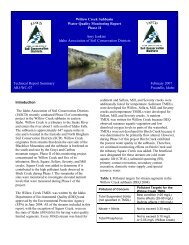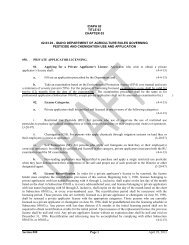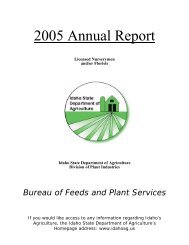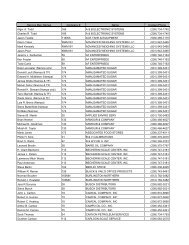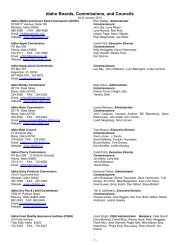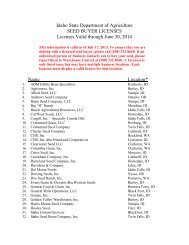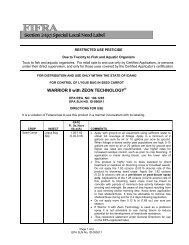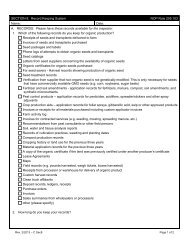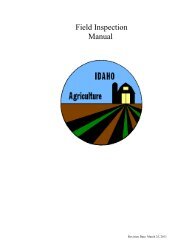2008 Statewide Strategic Plan for Eurasian Watermilfoil in Idaho
2008 Statewide Strategic Plan for Eurasian Watermilfoil in Idaho
2008 Statewide Strategic Plan for Eurasian Watermilfoil in Idaho
You also want an ePaper? Increase the reach of your titles
YUMPU automatically turns print PDFs into web optimized ePapers that Google loves.
Bottom barriers are appropriate <strong>in</strong> water bodies that have <strong>Eurasian</strong> watermilfoil<br />
lightly scattered s<strong>in</strong>gly or <strong>in</strong> small patches with<strong>in</strong> the littoral zone, around docks<br />
where there are no large obstructions and also along short stretches of shorel<strong>in</strong>e.<br />
Cost and ma<strong>in</strong>tenance of bottom barriers conf<strong>in</strong>e them to very small-scale use.<br />
Follow-up is essential to ensure success with bottom barriers. Even a few<br />
<strong>Eurasian</strong> watermilfoil fragments left <strong>in</strong> the water can start a new <strong>in</strong>festation. Diver<br />
and surface <strong>in</strong>spections should cont<strong>in</strong>ue at least twice a year dur<strong>in</strong>g the grow<strong>in</strong>g<br />
season. Survey work should be as frequent as can be af<strong>for</strong>ded s<strong>in</strong>ce small<br />
<strong>Eurasian</strong> watermilfoil plants or fragments may be easily overlooked.<br />
C. Manual Controls<br />
1. Hand-pull<strong>in</strong>g<br />
Hand-pull<strong>in</strong>g and removal of rooted, submerged plants is a labor <strong>in</strong>tensive control<br />
method. This method <strong>in</strong>volves digg<strong>in</strong>g out the entire plant with its roots. <strong>Plan</strong>ts are<br />
then deposited <strong>in</strong> a dry disposal area away from the shorel<strong>in</strong>e. No specialized<br />
gear is required <strong>in</strong> waters less than three feet. In deeper waters, hand pull<strong>in</strong>g is<br />
most efficient with divers us<strong>in</strong>g snorkel<strong>in</strong>g equipment or SCUBA gear. Divers carry<br />
mesh bags to collect plants. <strong>Plan</strong>ts must be disposed of on shore. Hand pull<strong>in</strong>g<br />
can beg<strong>in</strong> as soon as <strong>Eurasian</strong> watermilfoil can be easily seen and identified -<br />
generally <strong>in</strong> the spr<strong>in</strong>g or as soon as it is discovered <strong>in</strong> the water body.<br />
Sediment type, visibility, and thoroughness <strong>in</strong> removal of the entire plant,<br />
particularly the roots, all affect the efficacy of hand-pull<strong>in</strong>g. A high degree of<br />
control, last<strong>in</strong>g more than one season, is possible when complete plant removal is<br />
achieved.<br />
Advantages of hand-pull<strong>in</strong>g <strong>in</strong>clude immediate clear<strong>in</strong>g of the water column. The<br />
technique is selective and is most useful <strong>in</strong> sensitive areas where disruption must<br />
be kept to a m<strong>in</strong>imum. It is a highly labor <strong>in</strong>tensive control option, most<br />
appropriate <strong>in</strong> small or low density areas. Environmental impacts, <strong>in</strong>clud<strong>in</strong>g<br />
turbidity and bottom disruption, are short-term.<br />
Hand-pull<strong>in</strong>g is time-consum<strong>in</strong>g and can be costly. Diver visibility may become<br />
obscured by the digg<strong>in</strong>g process, mak<strong>in</strong>g it difficult to see and remove roots.<br />
Hand-pull<strong>in</strong>g is not practical <strong>for</strong> large areas. This method is useful <strong>for</strong> small-area,<br />
short-term control of <strong>Eurasian</strong> watermilfoil around docks and along short shorel<strong>in</strong>e<br />
segments.<br />
2. Diver Dredg<strong>in</strong>g<br />
Divers operate portable dredges with suction heads that remove plants and roots<br />
from the sediment - essentially vacuum<strong>in</strong>g the bottom of the lake (Figure 14). The<br />
suction hoses draw the plant/sediment slurry up to a small barge or boat carry<strong>in</strong>g<br />
the dredge. On the barge, plant parts are separated from the sediment slurry and<br />
reta<strong>in</strong>ed <strong>for</strong> off-site disposal. The sediment slurry can be returned to the water<br />
column.<br />
28



